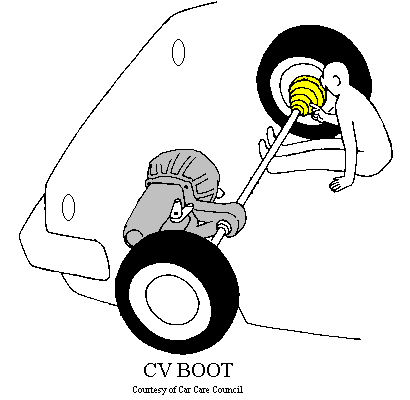PROPER CARE
Inspecting Your CV Boots
*MEDIUM*
CV boots must be periodically inspected for wear and tear. It is convenient to inspect them during every oil change. This is about every 3 months or 3,000 miles. Use the following procedure:
- Park the vehicle on level ground in a well-ventilated outdoor area. Turn the steering wheel to the full left or full right position, then back off about 1/4 turn. This spreads the CV boots. Turn the engine OFF, engage the parking brake, and place the transmission in PARK.
- Crawl under the car and identify the rubber CV boots. Wear gloves and a long sleeve shirt so as not to burn yourself on any components. Also wear eye protection so foreign particles like undercar dirt do not enter eye.
- Clean the boots with a wet rag to remove all exterior dirt and grease.
- Examine the condition of the boots with a bright light. If a boot is
torn, split or otherwise ruptured, or if it appears rotted, it must be replaced
immediately. Squeeze the boots to make sure they are airtight. If they are
not, they must be replaced. Move the car forward one foot a few separate times
to rotate the boots. Check the boot surfaces at each stop. Remember to turn
the wheels to spread the boots.
- Check the tightness of all boot clamps too. If a clamp is loose, dirt or water may have entered the boot and contaminated the grease. Peel back the loose boot and inspect the grease. If the grease is gritty, it is contaminated with dirt. If it looks milky white, it is contaminated with water. In either case, have the joint professionally serviced.
- Since boot replacement usually requires removal of the drive shaft axle, have the work done by a professional automotive technician. However, some CV boots do not require removal of the drive shaft axle and they can be wrapped around the joints instead. In this case, remove the damaged boot by loosening both clamps and cutting away the boot. Install the new wraparound boot according to the manufacturer's directions.
